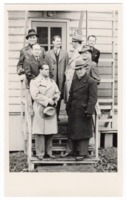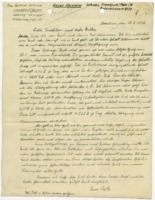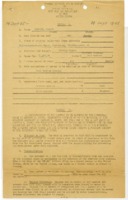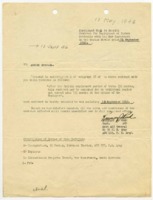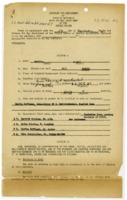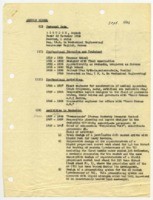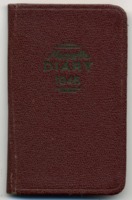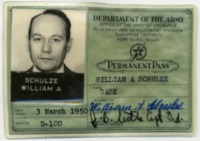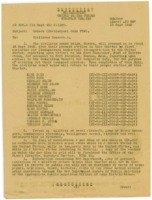
Browse Items (17 total)
Sort by:
-
Bernhard Tessmann and William A. Schulze with a group at Fort Bliss, Texas.
Tessmann is standing on the front row on the far left. Schulze is standing directly behind him. Tessmann and Schulze were both engineers who were relocated from Germany to the United States as part of Operation Paperclip after World War II. -
Transplanted Rocket Pioneers.
The information in this dataset is reproduced from Charles Lundquist's 2014 monograph Transplanted Rocket Pioneers. The information includes biographical and professional information that he compiled to produce the book. Each individual represented in the dataset also has a vertical file in the Lundquist Collection at UAH.
Transplanted Rocket Pioneers is a recognition of the early members of the von Braun rocket team, many of whom were key players in the successful moon landing. Many historians conclude that the lunar missions of the Apollo Program could not have been possible without the leadership and experience provided by a corps of engineers, scientists and managers transplanted from Europe to the Unites States after World War II. This fact motivated Dr. Lundquist to deposit this work in the Archives of the Library at the University of Alabama in Huntsville by assembling a file on each of the individuals who came from Europe to participate in the rocketry activities in Huntsville, or, in a few cases, individuals who had other ties to Huntsville.
This dataset includes a standard one-page summary sheet for each subject. Although most sheets are relatively complete, some data are still missing.
The first two lines on each page records fundamental identification information:
Family name Date of birth Place of birth Given names Date of death Place of death
The next standard entry is a statement of the extent of the Archives Holdings, either i) A primary collection of documents housed in one or more banker boxes, usually a separate individual collection ii) A secondary collection in a standard archive box, or iii) a file folder. Next, if there is an oral or video history for the individual, this fact is noted. A statement about the highest education levels of the individual follows. The next five entries, in chronological order, record whether the individual participated in activities at five sites:
1. Raketenflugplatz-Kummersdorf: Individuals engaged in the activities at these sites of early rocket development experiments sponsored first by VfR and subsequently by the German Army.
2. Peenemünde: Included here are individuals who participated in Peenemünde programs under several auspices, including as Army civilian employees, as members of the German military, as contractor employees on site or visiting as needed, and as university employees collaborating as required.
3. Fort Bliss: Individuals who were brought to Fort Bliss from 1945 to 1950.
4. GMDD-ABMA: Individuals who came to Huntsville, Alabama to work for the US Army rocket programs in the decade 1950 to 1960.
5th MSFC: Individuals who were employed by the NASA Marshall Space Flight Center in the 1960s.
Some people had various relationships with UAH and that is so noted. Additionally, a statement of immigration details is noted if pertinent. Finally, a great variety of incidental information is included under Incidental Remarks.
UAH Special Collections welcomes additions of biographical materials to the vertical file in the Charles Lundquist Collection. Please note that the work is that of Dr. Lundquist and may contain errors or omissions which are solely the product of his work on the project, as noted in the introduction of the work.: " Finally, it is pertinent to note that any document containing large files will surely have some mistakes or omission. Any errors are the responsibility of the author alone." As was the wish of Dr. Lundquist, we will strive to make factual corrections to the online copy when necessary.
-
Letter from August Schulze in Aberdeen, Maryland to Trude and Erika Schulze in Landshut, Bavaria, Germany.
Schulze wrote this letter to his wife, Trude, and daughter, Erika, on the back of a photostat copy of his War Department Notification of Personnel Action. In the letter, he discusses his pay and accommodations with the U. S. Army. -
Special Contract for Employment of German Nationals with the War Department in the United States.
This special contract outlines the conditions of August Schulze's employment as an engineer in the United States. The document also includes instructions regarding the engineers' housing, dependents, mail, termination of contract, and burial. -
Supplements to Special Contract for Employment of German Nationals with the War Department in the United States.
The two supplements extend August Schulze's employment in the United States to November 21, 1946. On the back of Supplement No. 2, Schulze lists amenities and their prices. -
Contract for Employment of Foreign Nationals with the War Department of the United States.
This contract outlines employee benefits, policies regarding the movement of dependents from Germany to the United States, and conditions of secrecy, noting that "as a condition to admittance to this country and employment hereunder, employee agrees to observe such security measures as the President of the United States may direct with respect to the project here involved." The contract also includes an enclosure clarifying that Schulze's wife and daughter may move to the United States as soon as possible. -
Résumé of August Schulze.
This résumé outlines Schulze's professional activities and activities in rocketry. The document notes his interrogation by the United States and outlines plans for his "Contemplated Activity" as "Chief of the Subsection 'Thrust Unit'." -
1946 day book.
Written by William A. Schulze, this day book includes notes from his activities at Army Proving Ground at Aberdeen, Maryland in early 1946. Schulze was transported from Germany to Aberdeen in late 1945 as part of the first group of German engineers sent to the United States. During the week of March 17-23, Schulze records his travel from Aberdeen to El Paso, Texas, leaving on Monday, March 18, and arriving in Texas on Thursday, March 21. The day book includes entries on shopping, leisure activities, birthdays, and mail. Schulze's notes reference H. N. Toftoy, Konrad Dannenberg, Wilhelm Jungert, Hannes Luehrsen, Theo Poppel, Erich Neubert, Walter Schwidetski, and others. -
Department of the Army Permanent Pass.
This pass was issued by the Office of the Chief of Ordnance, Research and Development Division Suboffice (Rocket), at Fort Bliss, Texas. -
Orders for the transportation of seventeen German civilians to the United States.
This document identifies the first group of German engineers to be brought to the United States as part of Operation Paperclip. Seven of the men listed were eventually transported to the U. S. Army post at Fort Bliss, Texas: Wernher von Braun, Wilhelm Jungert, Erich Neubert, Theo Poppel, Eberhard Rees, August Schulze, and Walter Schwidetski. The men were transported from Germany by air and then by train once in the United States.
